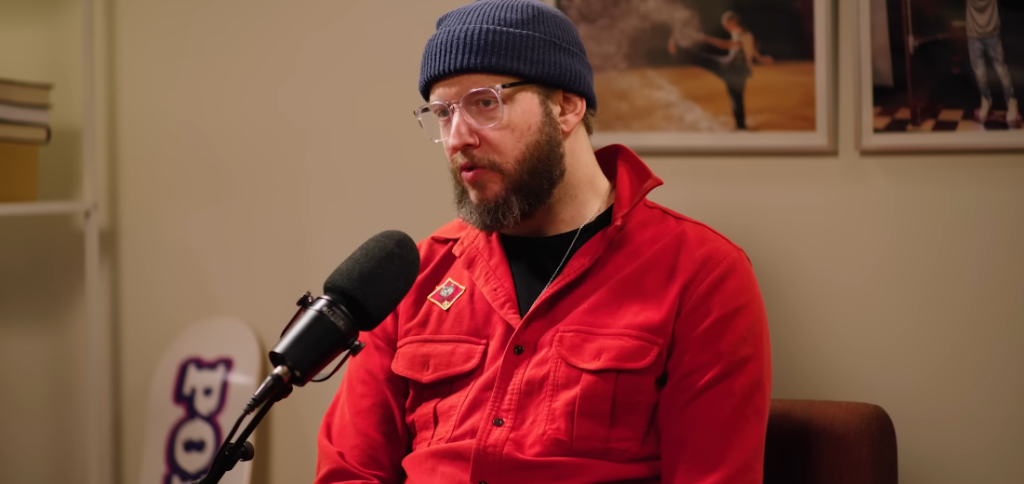The artwork of Justin Vernon frequently resembles an emotional weather report, foretelling clouds and then revealing light as the rain begins to fall. Although his music uses metaphors, the narrative of his most recent piece is firmly rooted: a relationship that wasn’t quite a relationship but nevertheless profoundly impacted him. Naturally inquisitive fans followed hints from interviews and lyrics to headlines and social media posts, particularly after a picture of Vernon holding a baby with actress Cristin Milioti went viral. After sparking rumors, the picture sent the internet into a frenzy.
As Vernon subsequently explained, it was not a paternity debut or pregnancy announcement, but rather a picture from the photo book that came with his most recent album. It wasn’t his baby. His partner wasn’t the woman. The fascination persisted, though. The reason for this is that when a song is written that cuts so deeply, listeners will naturally want to know who caused the injury—or the recovery.
Justin Vernon – Personal & Professional Profile
| Category | Details |
|---|---|
| Full Name | Justin DeYarmond Edison Vernon |
| Date of Birth | April 30, 1981 |
| Age | 44 years (as of 2025) |
| Profession | Singer-Songwriter, Producer, Multi-Instrumentalist |
| Primary Project | Bon Iver (Founded 2006) |
| Known Relationships | Kathleen Edwards (2010s), rumored association with Cristin Milioti (2025) |
| Latest Album Inspired By | Sable, Fable (2025) |
| Collaborative Credits | Taylor Swift, Kanye West, Charli XCX, James Blake, Aaron Dessner |
| Reference Source | https://www.theguardian.com/music/2025/apr/11/bon-iver-justin-vernon-new-album |
Vernon’s recent interviews reveal a delicate evolution rather than a conventional breakup story. The individual in question was someone who came into his life during a time of extreme emotional instability and restored its tranquility; they were neither a current girlfriend nor a past flame. He remarked, “She is a major part of my life, but it wasn’t in the cards to say, now we’re together.” That framing is incredibly honest; it avoids romantic clichés and instead discusses emotional legacy.

His album’s Fable half, which features ecstatic rhythms and innocent lyrics, musically reflects that legacy. “Everything Is Peaceful Love,” the lead single, is almost comically happy. Vernon likened the sensation to climbing a tree and discovering he had no idea how to descend—vulnerable, euphoric, and a little afraid of what might happen next. Considering his well-known battles with identity, anxiety, and the price of artistic fame, this metaphor seems especially potent.
Vernon has progressively withdrawn from the spotlight during the last ten years. He canceled his tours. He resisted the press. As his collaborations grew, his music grew increasingly abstract. His personal story was purposefully kept hidden, with his voice appearing next to Taylor Swift’s and his synths behind Kanye West’s monologues. For Vernon, the move toward seclusion was a remarkably successful means of self-preservation rather than a retreat.
However, Sable, Fable signifies a gradual restoration of clarity. Songs like “Awards Season” and “There’s a Rhythmn” glisten with emotional openness. They recognize that love doesn’t always require a label in order to make an impact. This method has grown in importance when discussing intimacy and masculinity. Previously, male songwriters were supposed to either cry aloud or act indifferent, but Vernon provides a middle ground that is based on introspection and allowing oneself to change.
Some of his earlier work is said to have been influenced by his relationship with Kathleen Edwards. Despite its significance, that relationship ended quietly, and both parties went on to pursue new creative endeavors. New music was released by Edwards. Vernon continued to concentrate on Bon Iver, making more music while doing fewer tours. There was no dramatic fallout or scandal. Rather, there was room for expansion, which is still a very uncommon result in partnerships with a public audience.
More recently, a photo rather than an official statement sparked interest in Vernon’s purported relationship with Cristin Milioti. No confirmation was provided by the two artists, who are both private and prone to misunderstanding. Nevertheless, the image—a baby in arms, shared openly—felt personal enough to inspire countless fan essays and Reddit threads. In the end, it was just a masterfully staged moment.
In an interview, Vernon acknowledged that he used to have frequent dreams about getting married. When he was younger, he thought of love as a place to be—stable, final, and earned. At 44, however, he now sees love as an influence rather than a stabilizing force. He told The Guardian, “I have to make that peace for myself.” Anyone who is debating whether relationships need to result in permanence in order to be meaningful will find the revelation especially pertinent. His answer is no, and he says it gently but firmly.
This openness is reflected in his recently revitalized creative process. Joy, not pain, was the foundation of the Fable sessions. The project was joined by Danielle Haim. He was asked to remix it by Charli XCX. These were discussions between artists learning to navigate vulnerability with hope, not merely joint ventures. For Vernon, who once told interviewers that he would welcome being struck by a bus just to feel something different, the tone shift is noticeably upbeat.
He isn’t preparing for impact anymore. He is writing from a place of grounded hope, embracing silence, and breathing through tension. It has become particularly relevant to use the metaphor of climbing that tree and sitting in its branches, enjoying the view but not knowing how to descend. Vernon is no longer attempting to flee. All he’s doing is learning to stay.
In a time when complexity is often penalized and oversharing is frequently rewarded, this gradual emotional recalibration is particularly significant. For those in the creative industries who wish to express themselves without being taken advantage of, Vernon’s willingness to identify emotions and his refusal to name names provide a model. His narrative demonstrates that vulnerability and privacy are frequently partners in the same reality rather than mutually exclusive.
Vernon’s approach to love has changed to one of tenderness. He characterizes his previous self as pursuing suffering, acting depressed, and contributing to a cycle of approval that ultimately drained him. However, something changed as a result of stopping smoking, breaking harmful habits, and gradually removing oneself from performance. He began making the kind of peace he could live in instead of pleading for love to save him.
At last, there is a sound to that tranquility. It is rhythmic, textured, giddy at times, but never reckless. Fans who used to cling to his heartbreak songs as if they were gospel might need to adapt to this new chapter. Vernon, however, sees it as evidence of advancement—a sign that the author of For Emma, Forever Ago has now discovered motivation to write something softer and more enduring.
Additionally, listeners may be overlooking the more intriguing reality if they are still trying to figure out who “Justin Vernon’s girlfriend” is. The individual was important. However, so did the album she inspired, which reclaims joy rather than chasing pain. That change is not only welcome, but subtly revolutionary in a creative field that has historically been characterized by emotional chaos.


